When in Rome! What a fantastic day for Team Agee in this great city. We left our hotel around 7:30am to begin our adventures. For today we had two guided tours booked for the Vatican in the morning and the Colosseum in the afternoon.
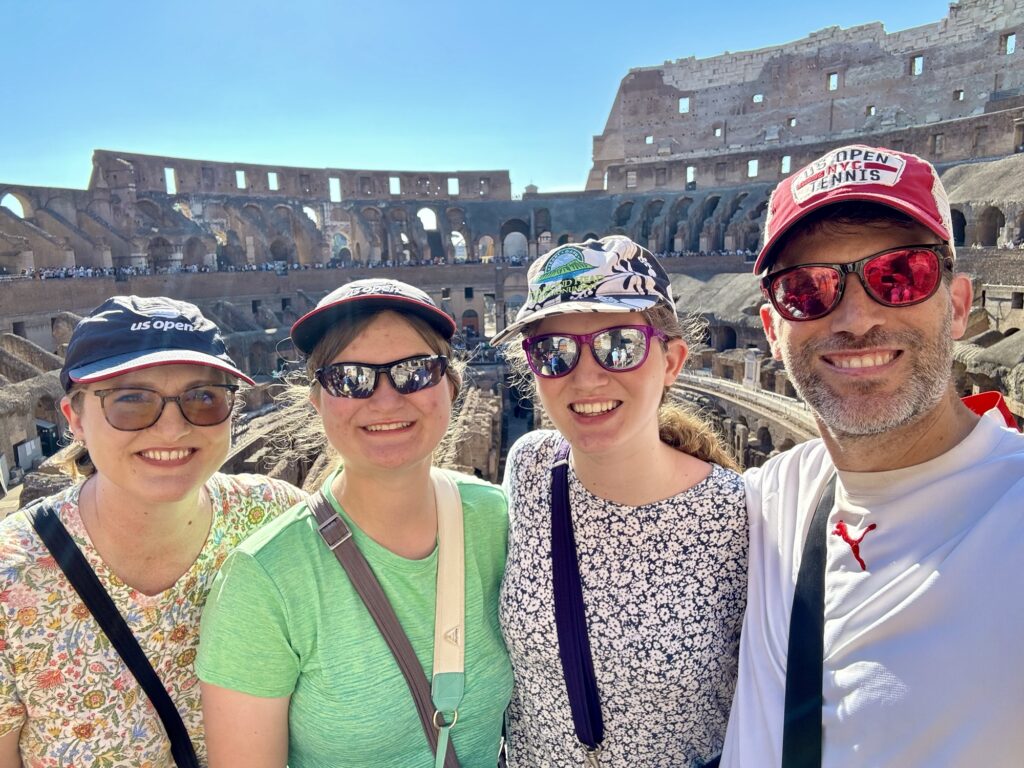
For the Vatican tour, we took the Metro A Line from our hotel to the Ottaviano stop across the river. Before the tour, we went to Trecaffè for breakfast as recommended by our friend Chris from back in college days.
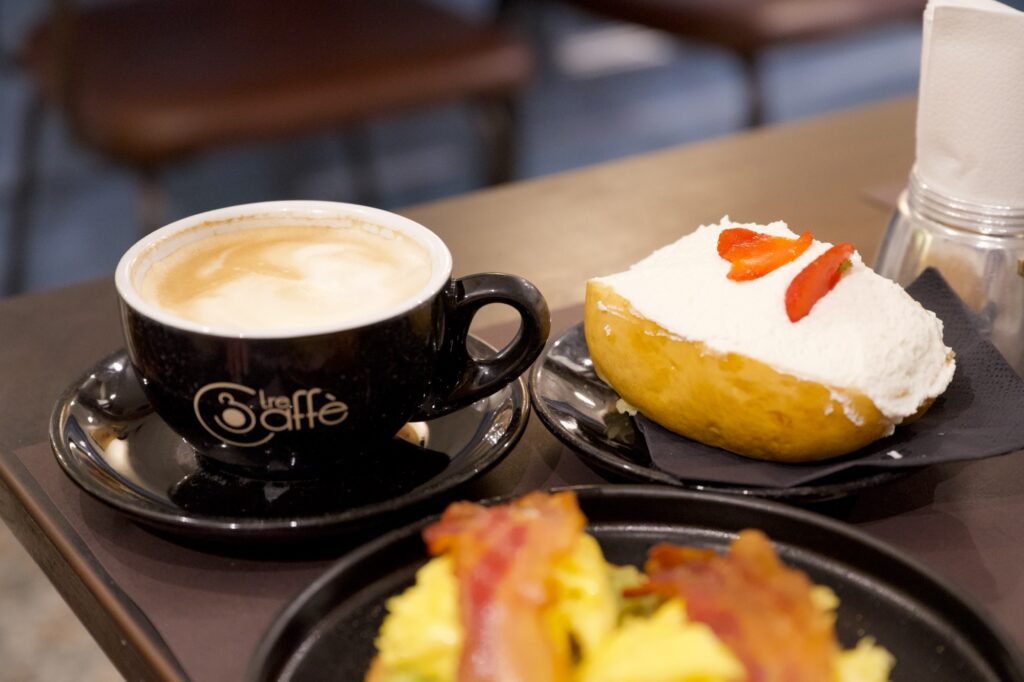
Kate, Olivia, and I all had a cappuccino. Sara tried a spoonful but was not impressed! However, she did say that it was better than the other times she has tried coffee, so there’s that.
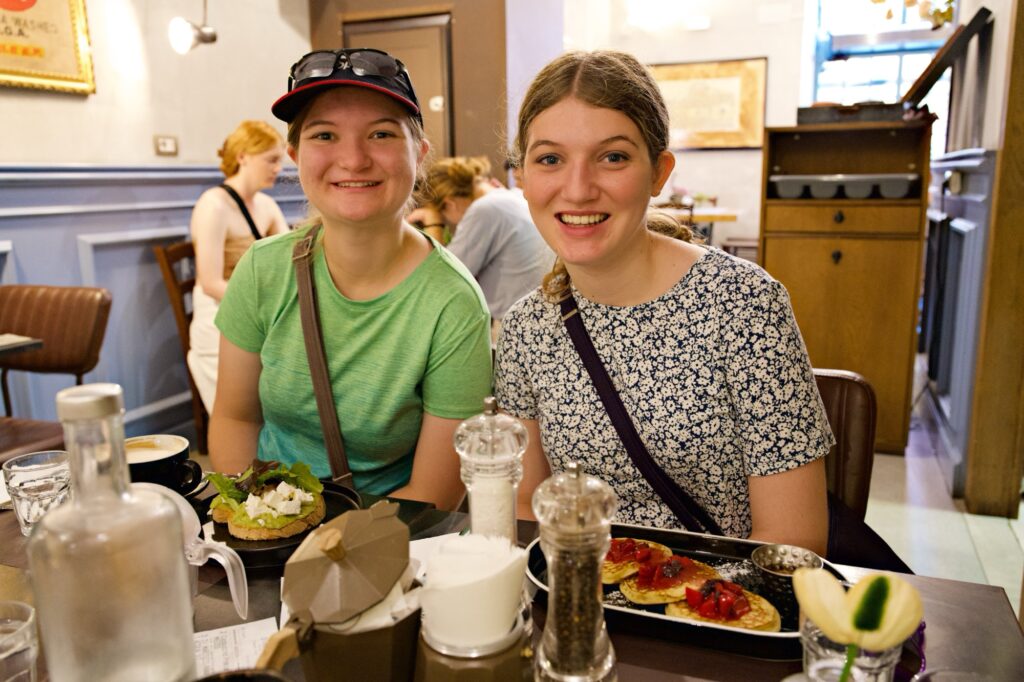
I had a ham and cheese omelet, Sara had pancakes, and Olivia and Kate both had avocado toast with various toppings. We also all tried a Maritozzi, which is an Italian pastry. This meal was wonderful!
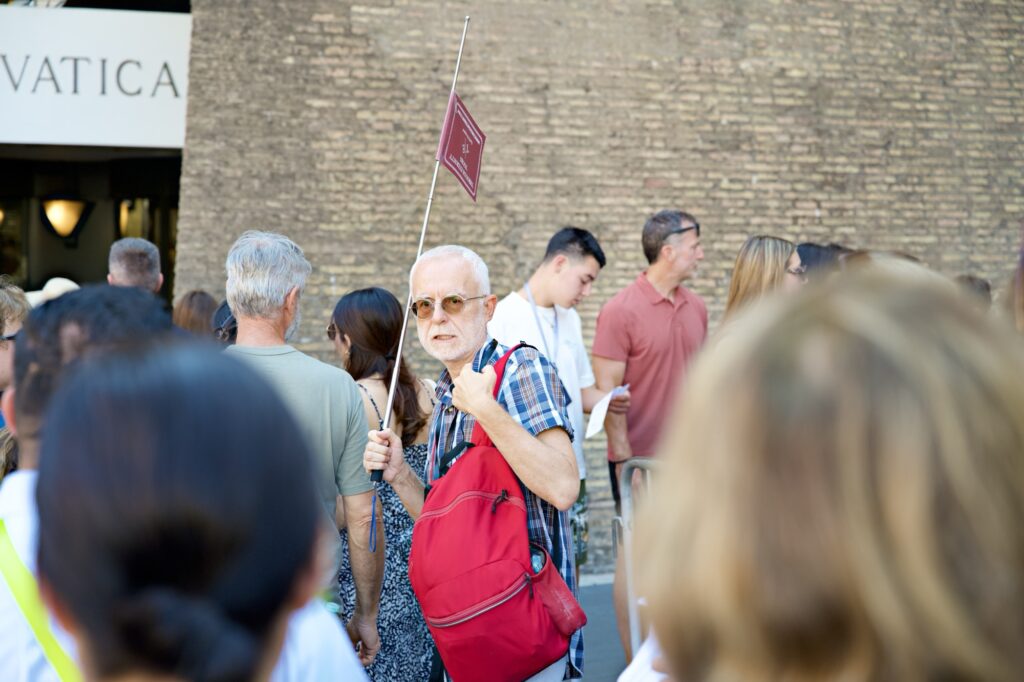
After breakfast we met our tour guide at flower stand near Vatican City just after 9am. His name was Paolo and he said that he was born and raised in Rome. After a short walk we picked up our headsets and got in line for the Vatican Museum by the outer walls of Vatican City.
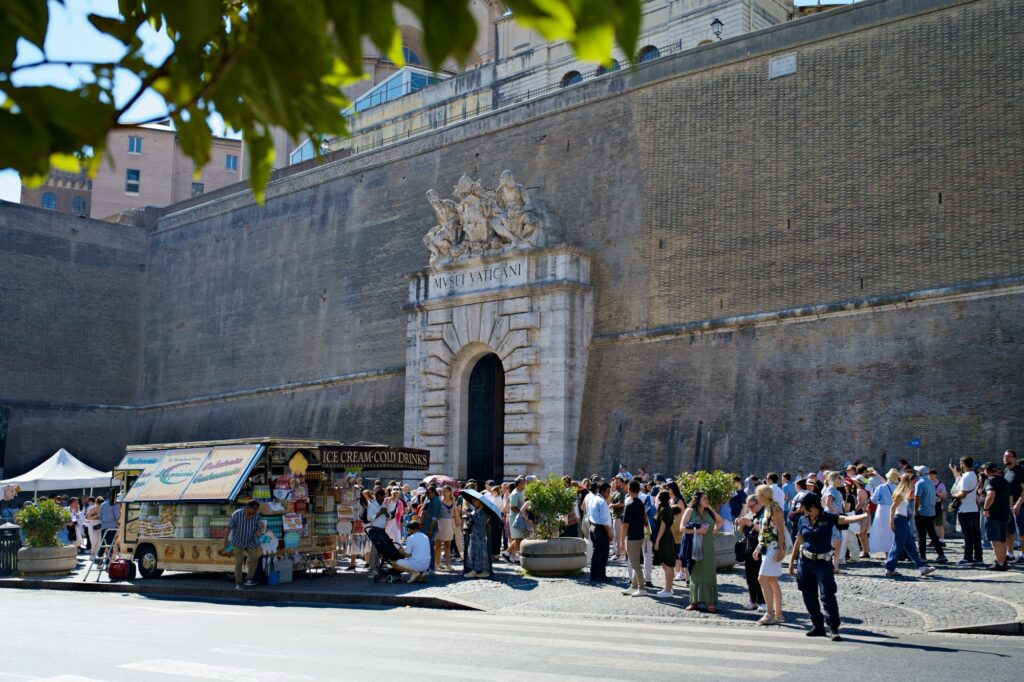
Paolo told us that the city is surrounded by 5 miles of walls that are 500 years old. It is crazy to think that technically inside those walls is a different country. It is the smallest independent nation in the world, eight times smaller than Central Park in NYC.
He said that 750 people live in Vatican City and another 2000 come in every day to work. Anyone who works there must be a multi-generational Catholic. It is a very desired place to work as there are many privileges such as no VAT and gas that is 1/3 the cost of the price in Rome.
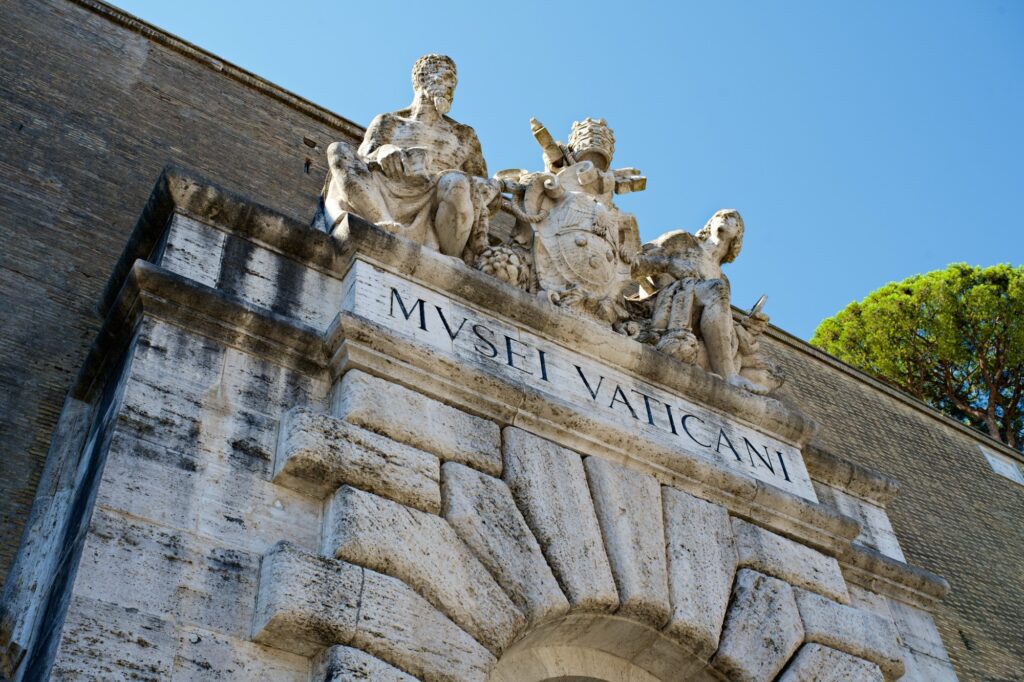
As we were about to go through security he also told us that the Vatican receives 38,000 visitors per day, which is astounding. It was certainly crowded! Maybe more crowded than anywhere I’ve ever visited except for my first time in the Church of the Holy Sepulchre in Jerusalem back in 2020.
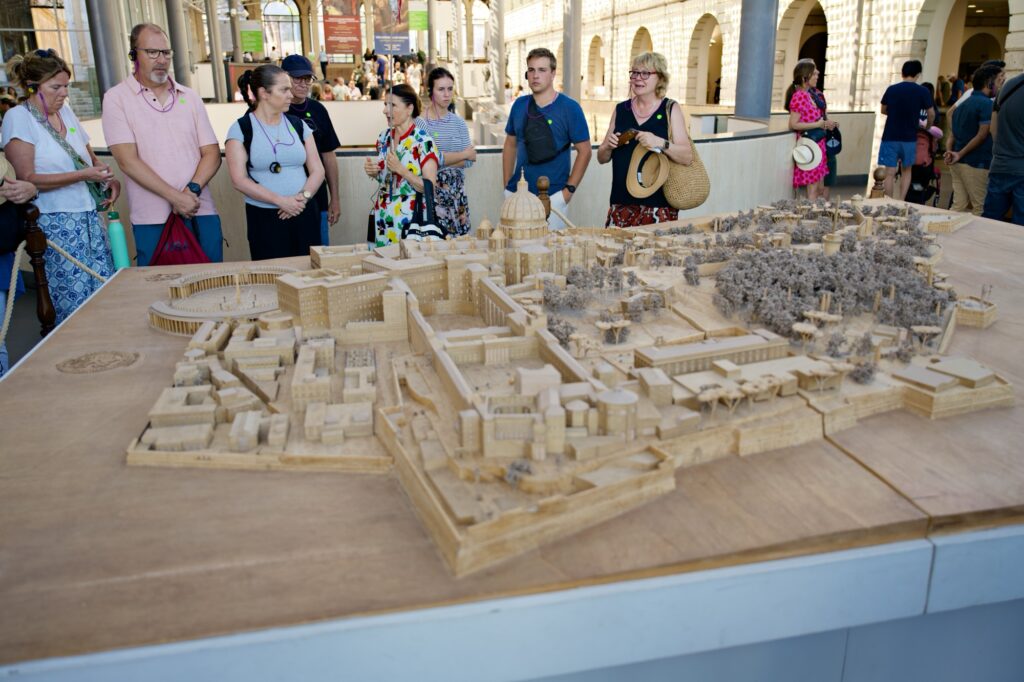
After security, our first stop was a model of Vatican City. Paolo pointed out the Country House, St. Peter’s Basilica, and the Museum, which is made up of the Country House and the Papal Palace. He talked about how the museum is not like other major art museums in that it is a converted palace. However, as I was going through it today, it very much reminded me of the Hermitage Museum in St. Petersburg, Russia, which is also a converted palace.
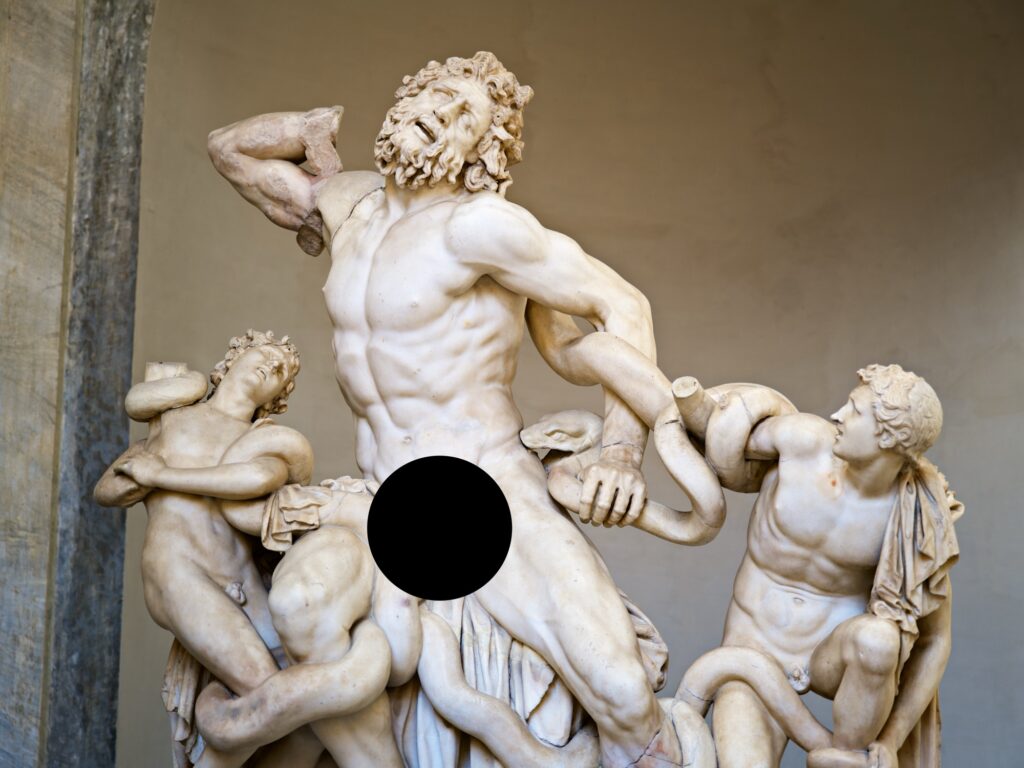
Next we began our tour of the Vatican Museum and here are a few highlights. One of Kate’s favorite things was being able to see the sculpture of Laocoön and His Sons. This is an ancient first century AD copy of an even more ancient bronze statue that no longer exists. Kate studied about this sculpture in an art class at Harding University last year. Paolo told us that the statue was found in pieces by a farmer who was plowing in 1505.
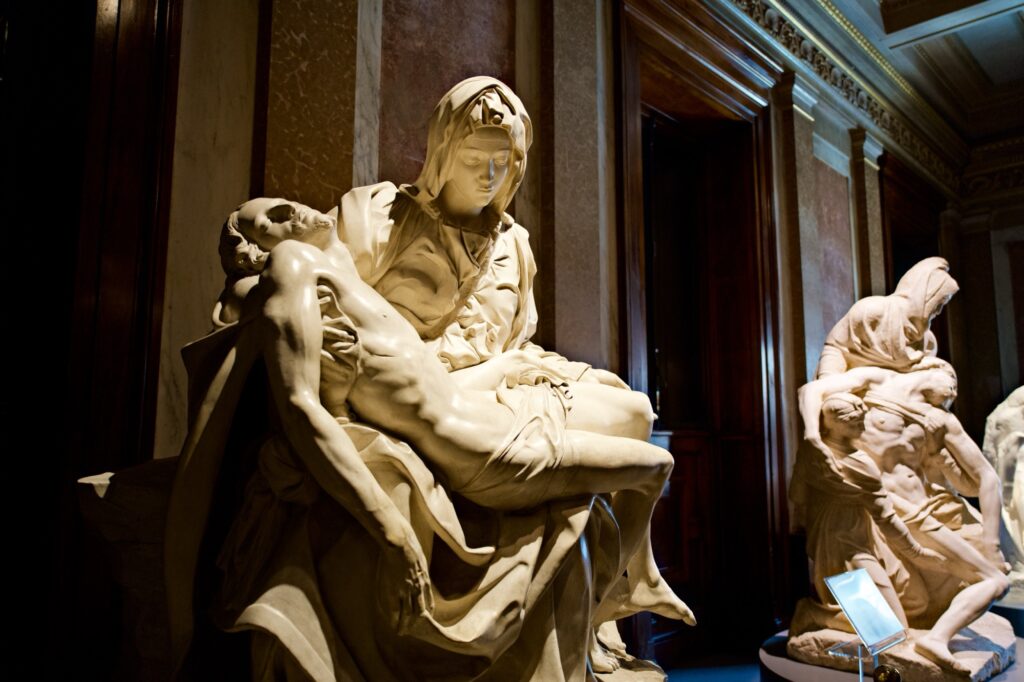
We saw a plaster reproduction of the Madonna della Pietà by Michelangelo and later the real thing from a distance in St. Peter’s Basilica. We were not able to get very close the the real sculpture due to this being the Jubilee year with many pilgrims coming to Rome.
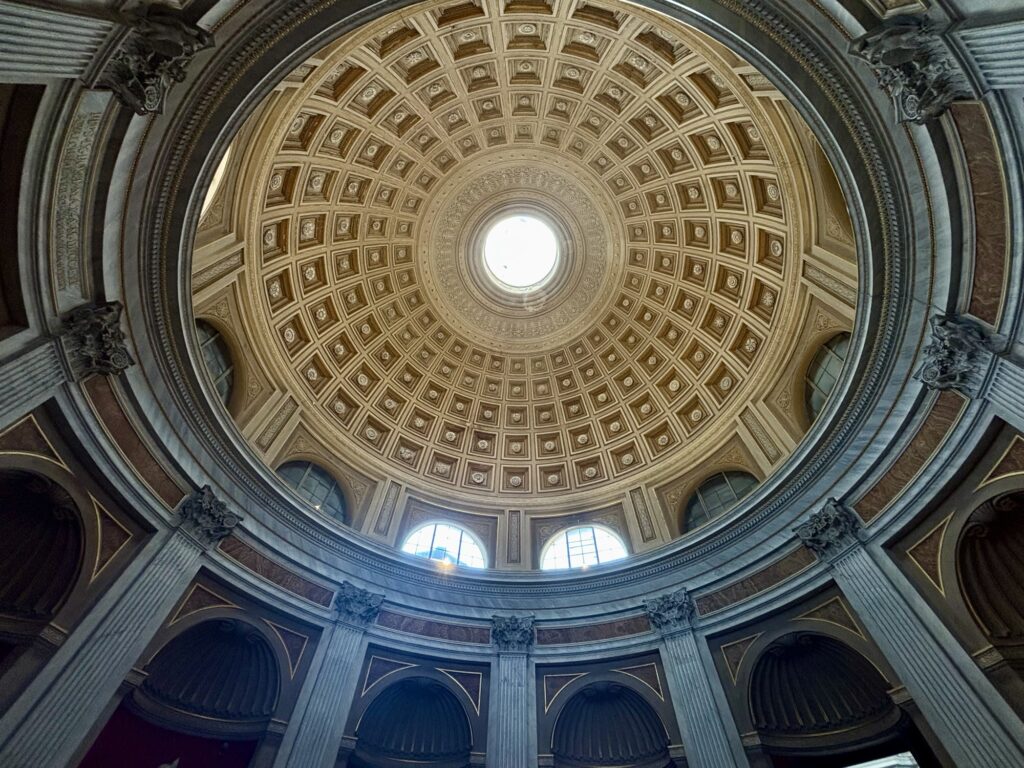
We visited the Round Hall which has a 17th century vault (dome) that was inspired by the Pantheon. However, unlike the Pantheon, the 3D look of this dome is created by painting. It is an optical Illusion.
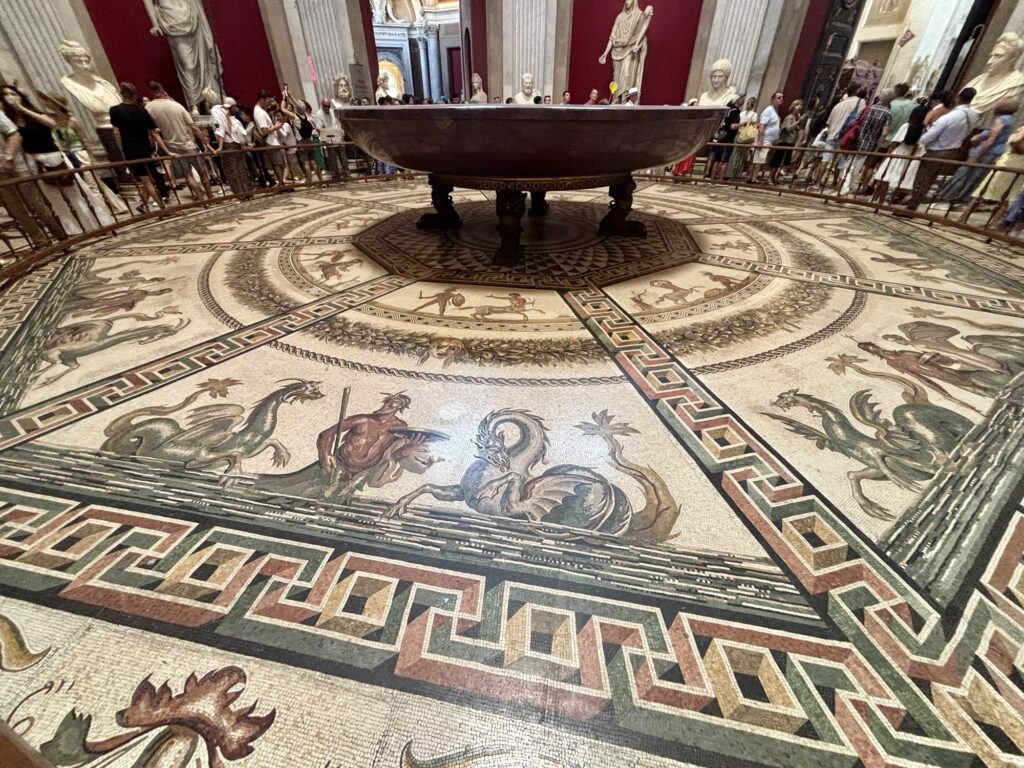
For me, the most striking thing about this room is the beautiful mosaic floor that was assembled in the 18th century from mosaics found at Otricoli and Sacrofano dating back to the first century AD.
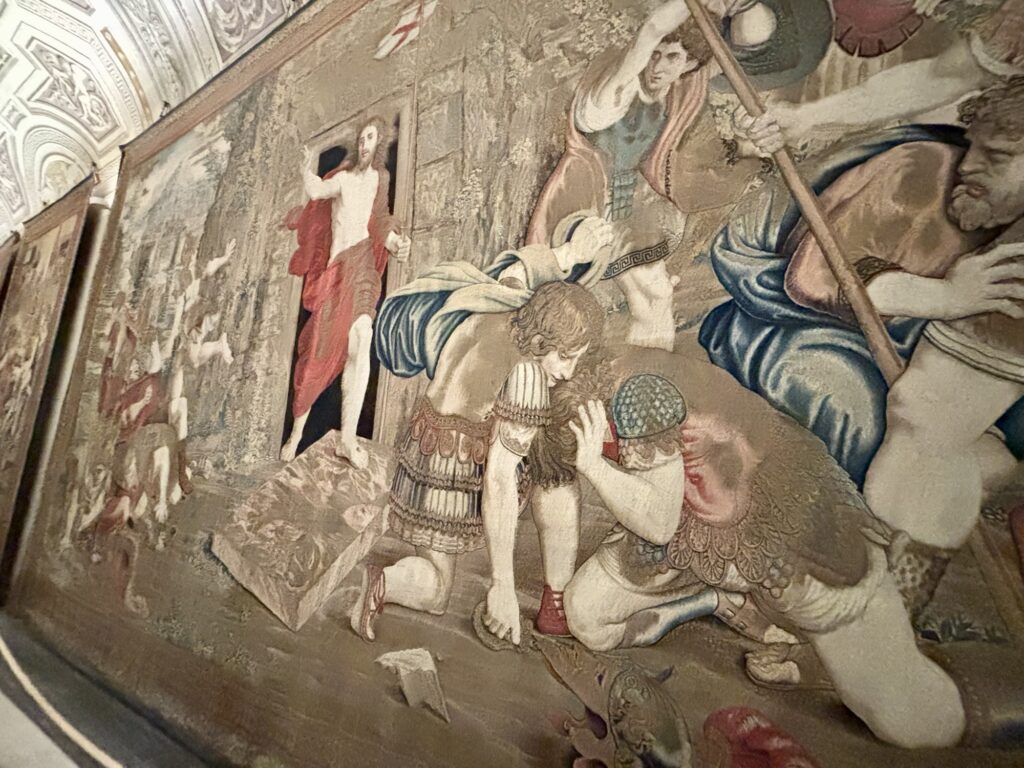
Another stop was the Tapestry Hall, which contained tapestries depicting the life of Jesus down the left hand side (the right side had to do with Papal history). My favorite of these was the tapestry depicting the resurrection.
We also visited the Sistine (Sisters) Chapel that was started in the early 16th century AD. There are no photos allowed and people are supposed to be silent. I saw a few people sneaking photos on their phone, but most people were talking. This was quite different than the reverent environment I was expecting. Paolo said that the reason for no pictures and silence is the preserve that paintings in the chapel (talking releases moisture).
From Paolo we learned that the Sistine Chapel is the private chapel for the Pope. It can be closed with no notice for his use. The shape of the chapel is rectangular with paintings on every surface. Facing the alter, all of the paintings on the left depict the life of Moses. I noted the Israelites crossing the Red Sea (Sea of Reeds), the giving of the Ten Commandments, and the reading the Law.
All of the paintings on the right depict the life of Jesus. I noted the Last Supper (with Judas sitting on the opposite side of the table from Jesus and the 11), the baptism of Jesus, and the Sermon on the Mount among others. Kate later noted how many of the figures we dressed in Renaissance era clothing.
Paolo explained that these paintings were made by many different artists including Michelangelo and Raffael. He said the intent was to show that the plan of salvation brought by Jesus was rooted in the ancient accounts like Moses. While I reject many aspects of Roman Catholicism, I wholeheartedly agree that God’s plan of salvation through Jesus is systematically revealed and made possible throughout the events of the Old Testament.
Paolo also explained that originally the ceiling was just the daytime sky before it was later painted by Michelangelo taking 3 1/2 years to complete. He also said that the legend of Michelangelo lying on his back was a myth and that he actually stood on the scaffolding.
Of course the centerpiece of the ceiling is the painting of God and Adam. I spent a lot of time taking in this great work. Additionally I noted paintings depicting Adam and Eve in the Garden of Eden with the serpent (and Lilith??) and also Noah and his sons.
27 years later, Michelangelo painted a judgment scene behind the alter with Jesus in the middle. I found it interesting that Michelangelo put a Cardinal in hell that he hated after the Cardinal had died. Paolo told us that after the death of Michelangelo, one of his proteges was brought in to cover the nude figures in chapel. I took note of this while in the chapel.
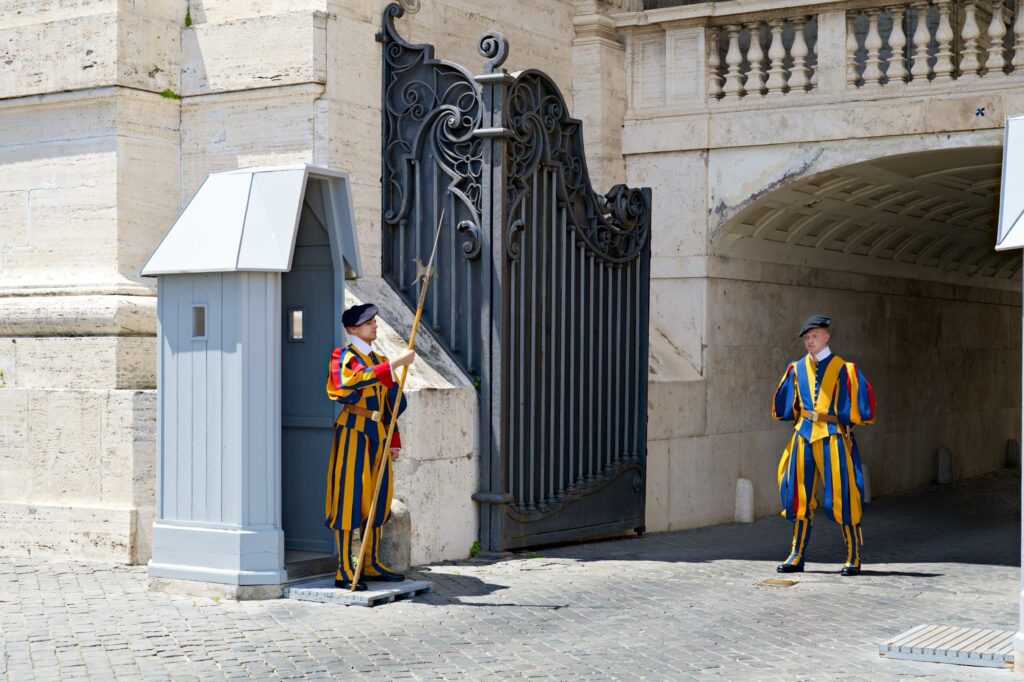
Upon leaving the chapel we saw multiple Swiss Guards dressed with brightly colored clothing like jesters. Since the population of Vatican City is so small, these guards come from Switzerland to serve as the Vatican security force.
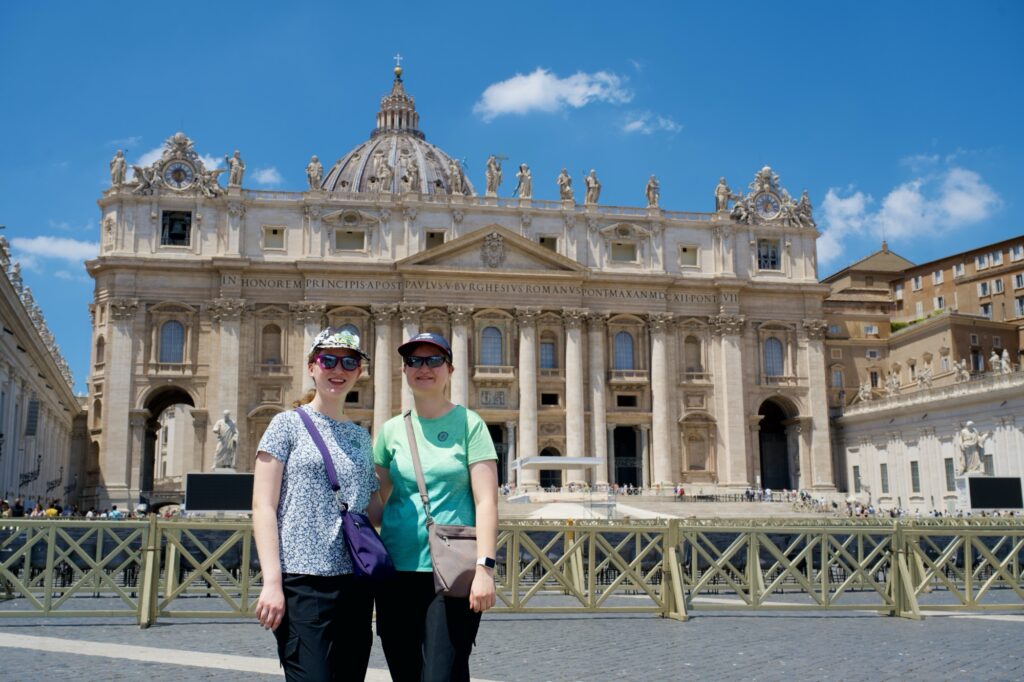
Our final stop was the Basilica of Saint Peter, which is the largest church building in the world. Paolo told us that the facade is as large as soccer field, and the entire structure is 66,000 square feet.
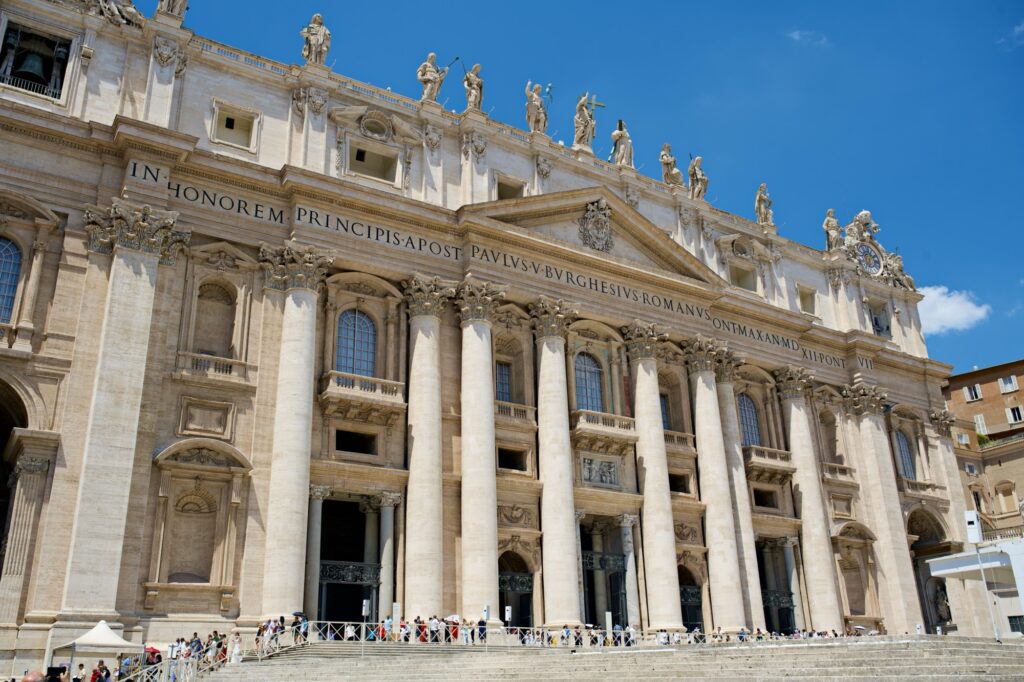
This Basilica stands on the traditional spot where the Apostle Peter is buried. There was an original structure that stood for 1200 years before being torn down to construct the current building was started in the early 16th century.
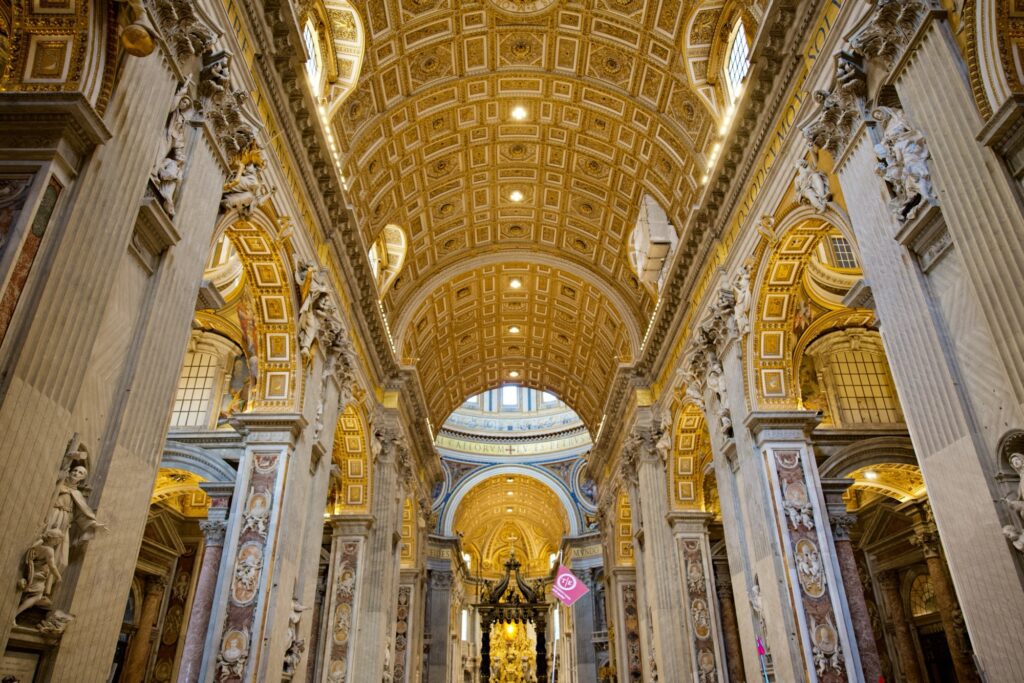
Inside, the Basilica is overwhelming. Paolo point out that all the gold surfaces are actual gold, and there are a LOT of gold surfaces. To my surprise, Paolo pointed out that Jesus would have been very unhappy with this use of gold. I absolutely agree, but was surprised to hear a guide say this.
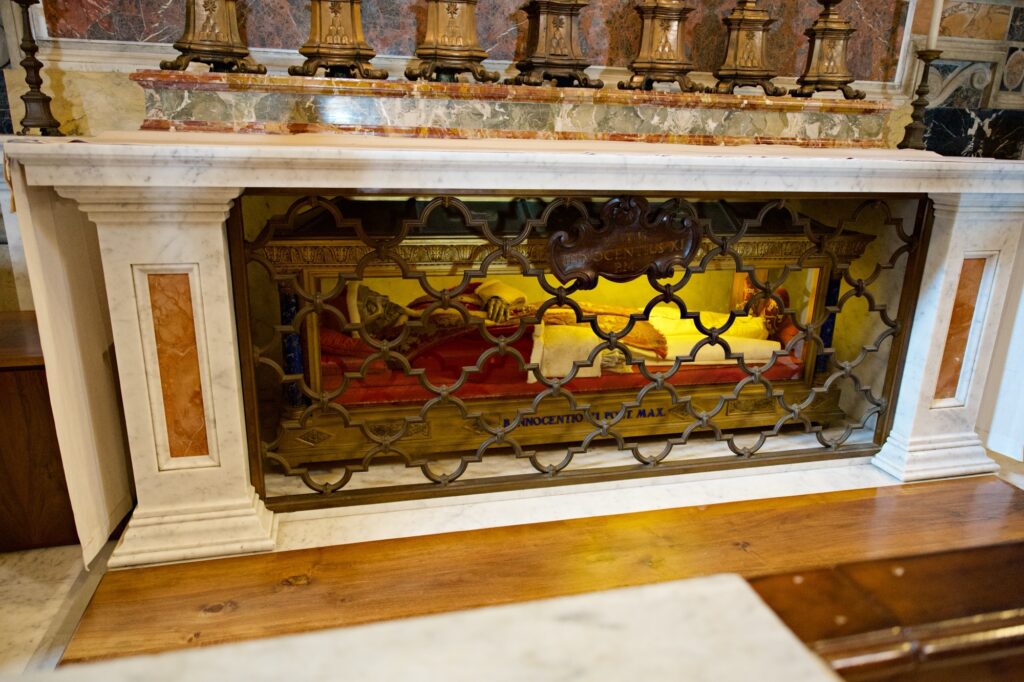
Paolo mentions that 124 out of the 257 Popes have been buried here. We saw the mummified remains of Pope Pius X with a wax mask of his face.
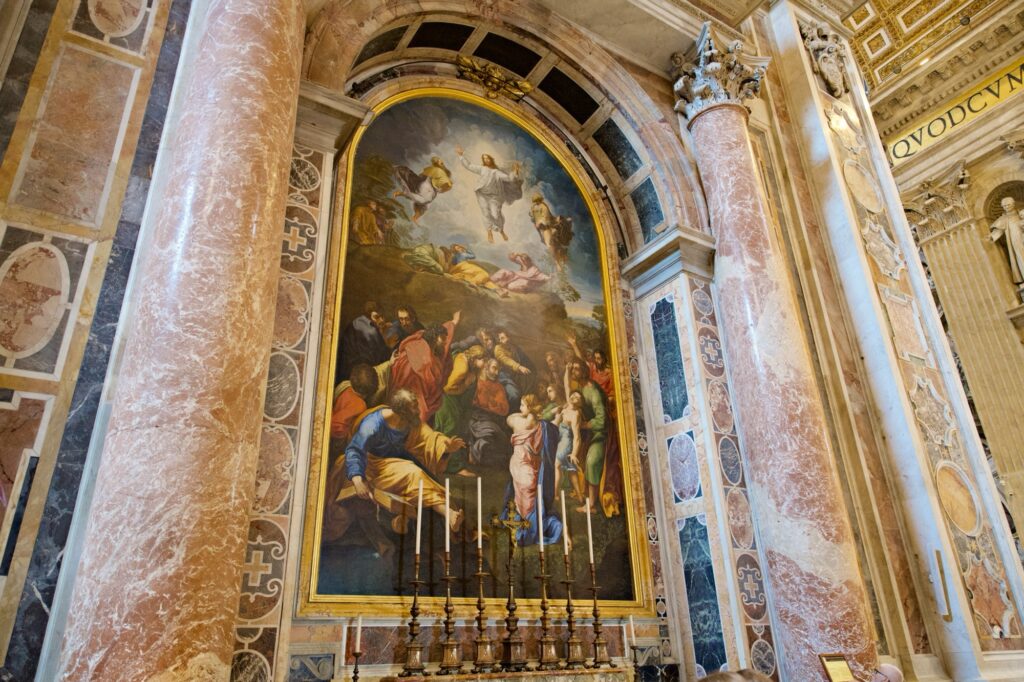
Mosaic reproduction of painting by Raphael, 1520
Above this mummy is a mosaic copy of a painting by Raphael. The pieces that make up the mosaic are so small it almost looks like the entire work is a single piece.
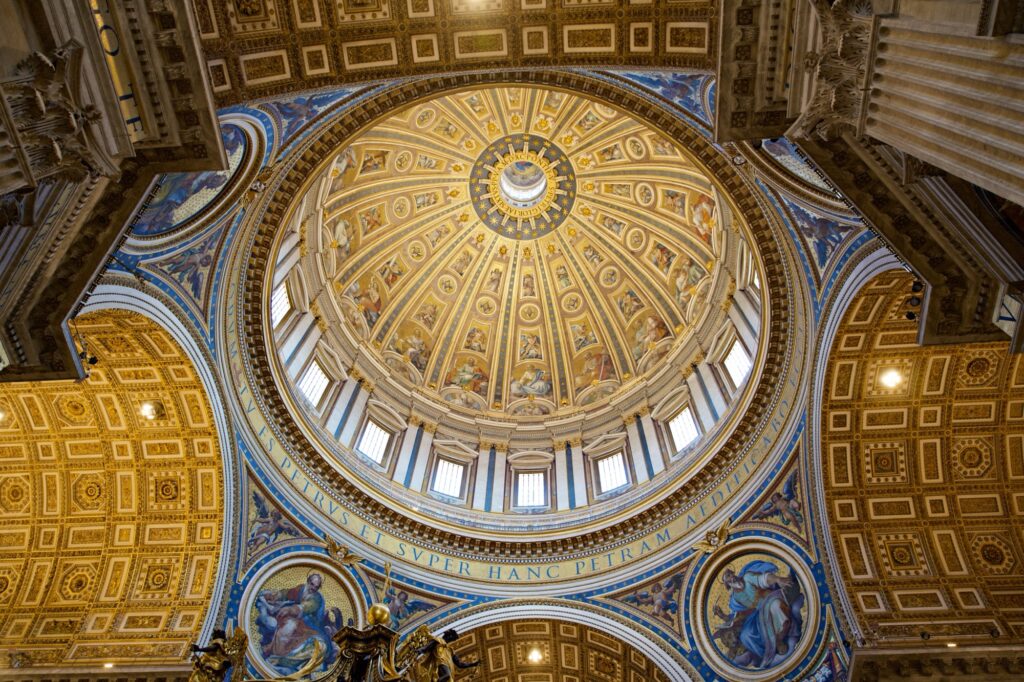
The dome in Saint Peter’s was designed by Michelangelo and is the tallest in the world. The dome is so large that the letters inside (and in other places inside the Basilica) are 4 feet tall.
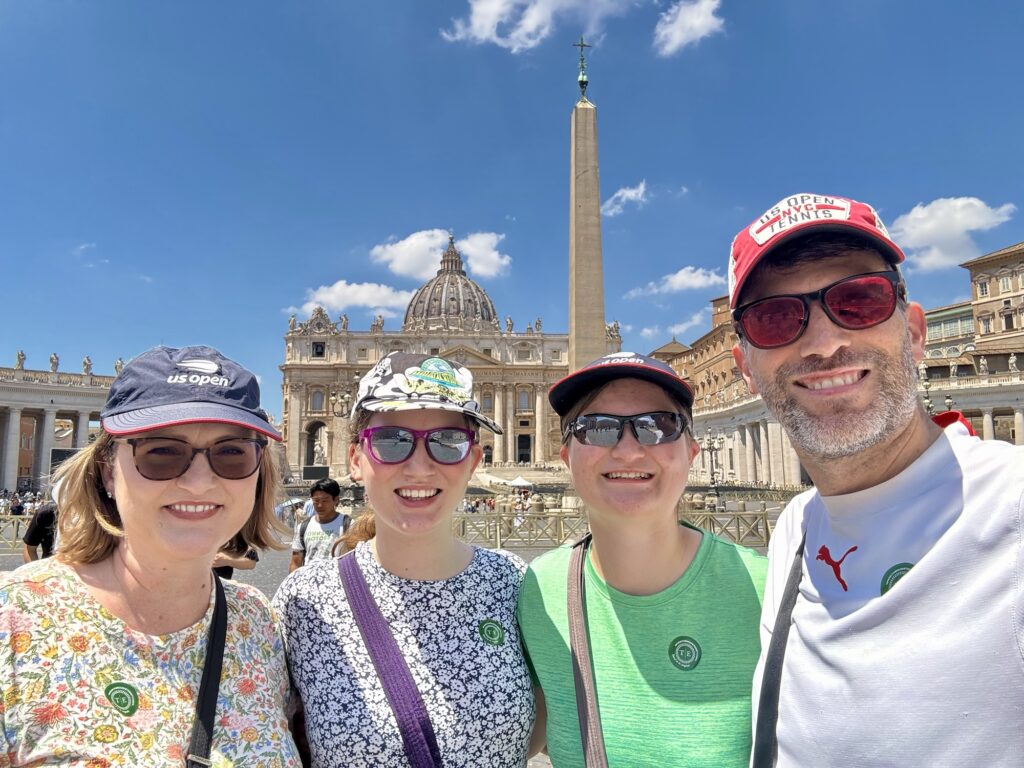
After taking our leave from Paolo, we exited through St. Peter’s Square before beginning our walk back to the Metro. We boarded Metro line A to make a quick stop at the hotel before heading to the Colosseum for our afternoon tour.
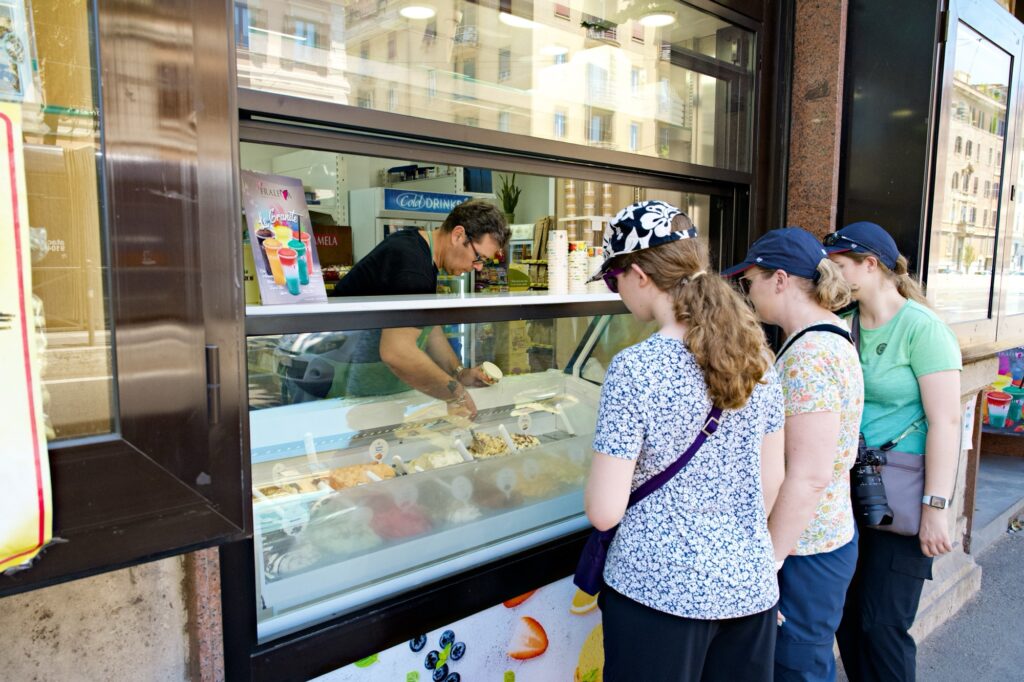
Along the way we stopped for a quick bite of gelato. This time Olivia and I tried tiramisu, Kate had pistachio and caffè, and Sara had chocolate. So yummy.
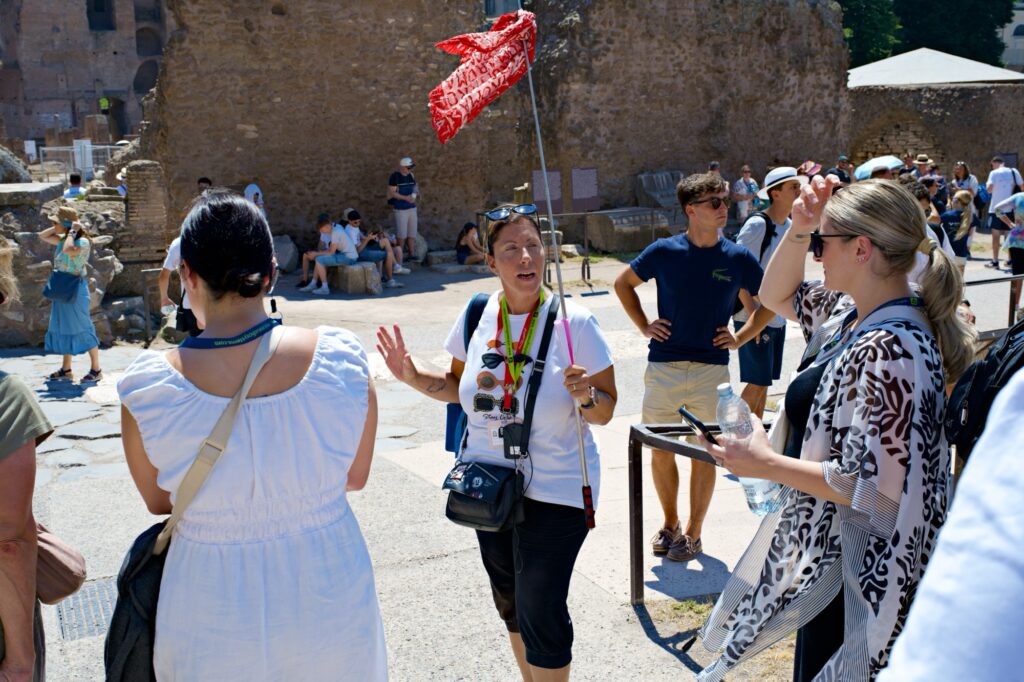
We met our guide Laura at a restaurant near the Colosseum for our afternoon tour. Laura is also a native of Rome, just like Paolo from the morning tour. Our first stop was the ancient Roman Forum.
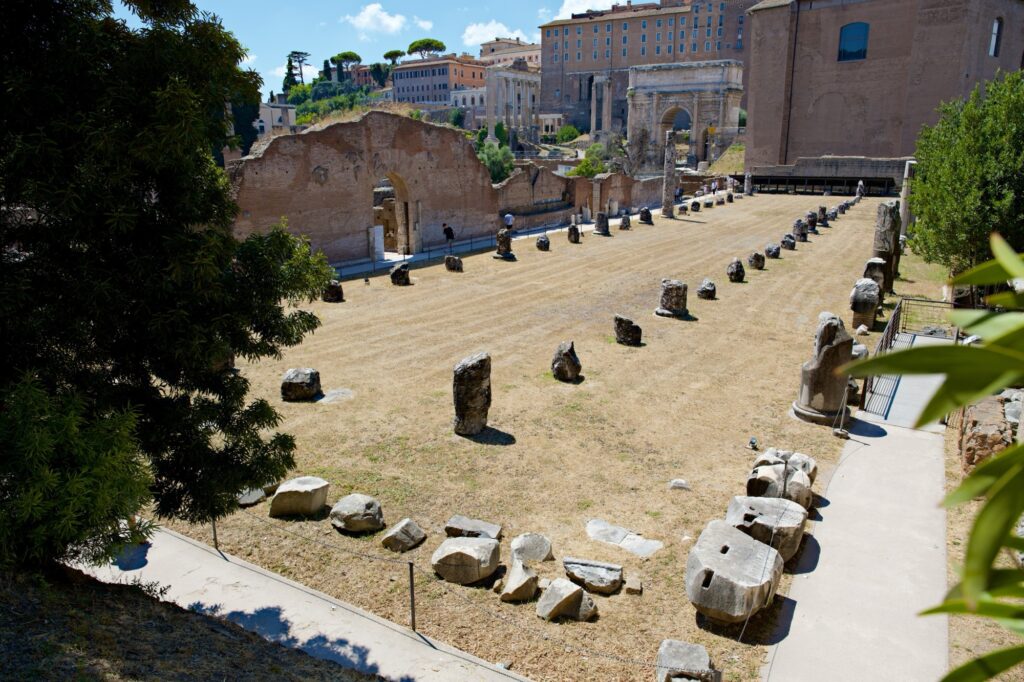
Per Laura, the Roman Forum was the heart of Ancient Rome. It was a place of much discussion, sharing of ideas, and debate. Some of the highlights of our tour included…
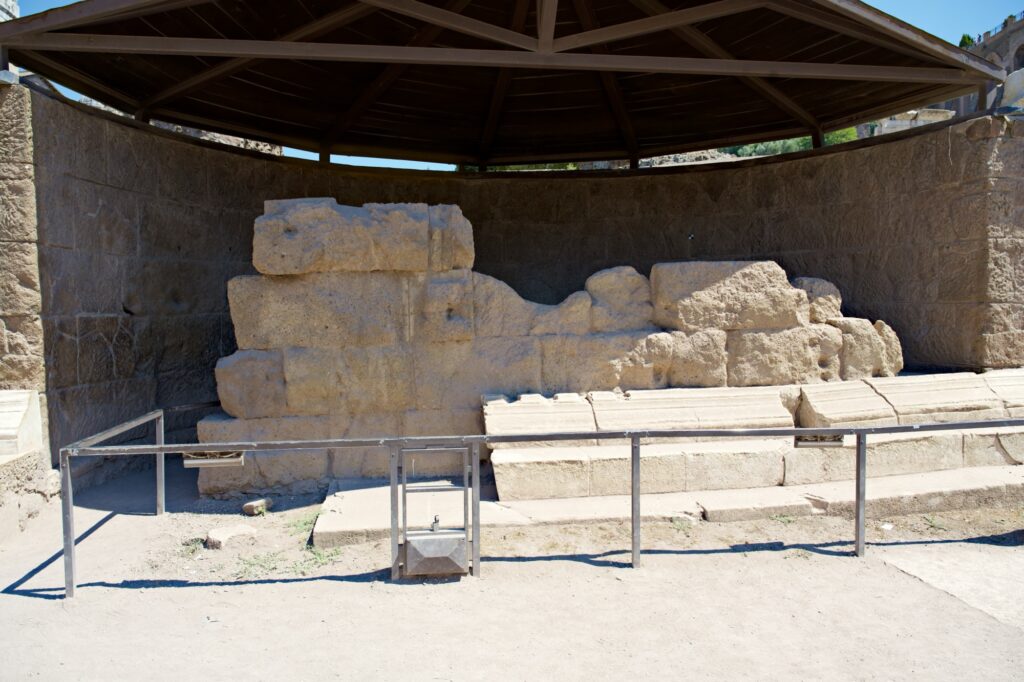
The remains of the Temple to Divine Julius dedicated to Julius Caesar who died in 44 AD and was considered to be divine upon his death. This temple contained a reproduction of Julius Caesar’s tomb.
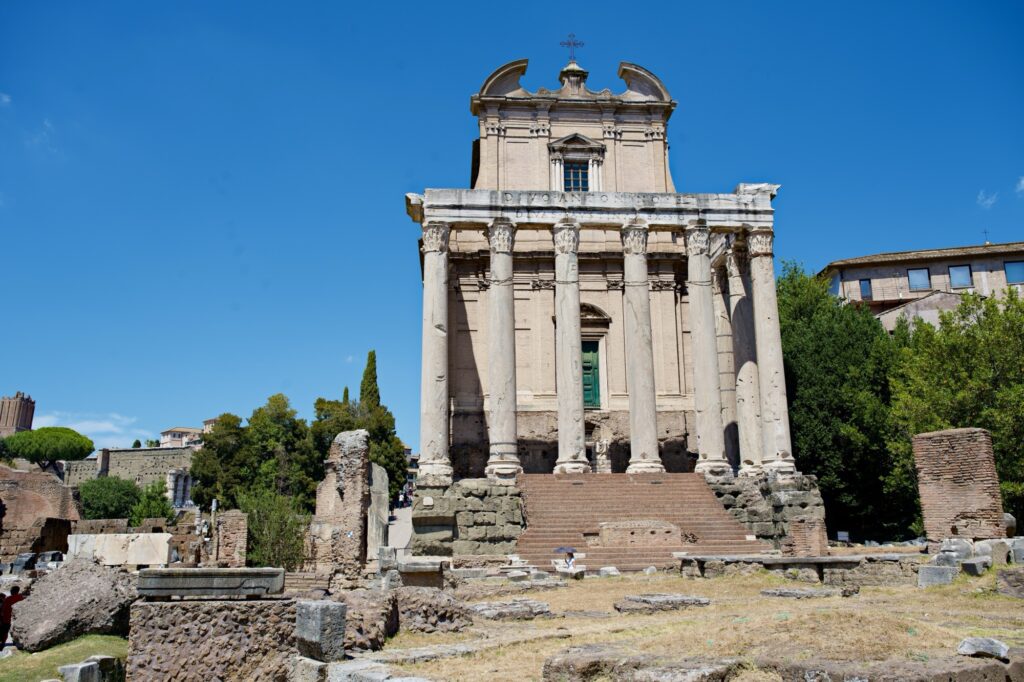
The Temple to Divine Antoninus and Faustina was built in 141 AD and is one of the more prominent remaining structures in the Roman Forumn. It has Egyptian style columns and was built by Antoninus for his wife Faustina. It was dedicated to Antoninus after his death. As with many temples in Rome, it was later converted to a church.
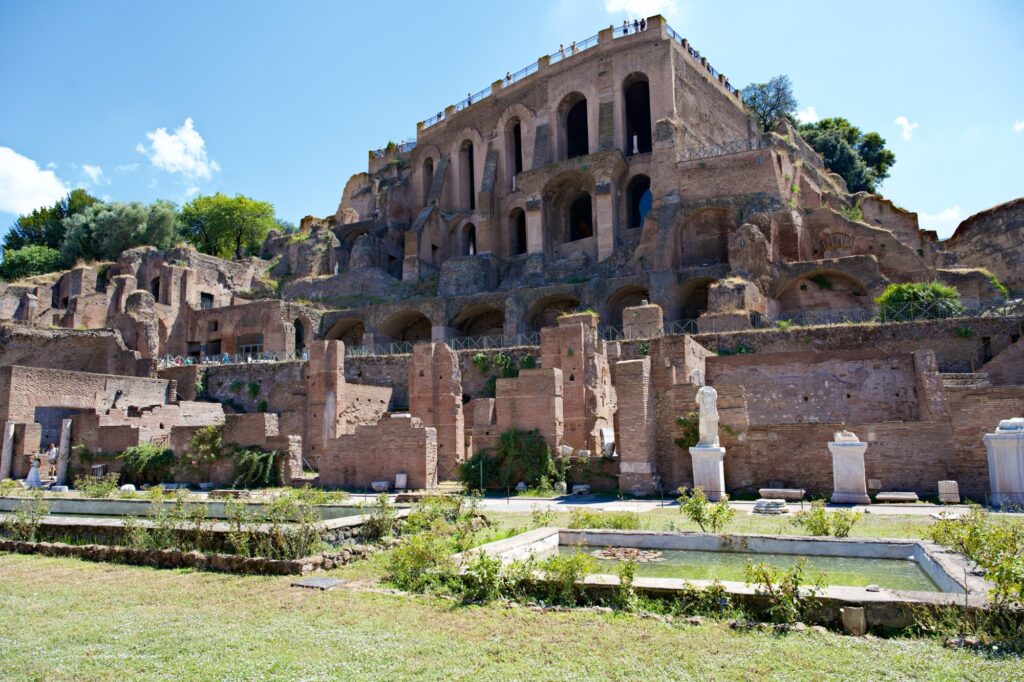
The area of Vestal Virgins. This was where the young women lived who were chosen to keep the eternal flame in the city. It was a position of honor and prestige, but the penalty of breaking their commitment to chastity was severe as they would be buried alive. Behind this area we could see the Temple of Apollo Palatinus on top of Palatine Hill, which we would climb later.

The Temple of Divine Romulus (not the mythical founder of Rome) was built by the Emperor Maxentius in 309 AD for his son Romulus who died. Romulus was deified by his father. Laura told us that the bronze doors of this temple are intact and still use the original mechanism. We briefly went inside this temple (now a church building).
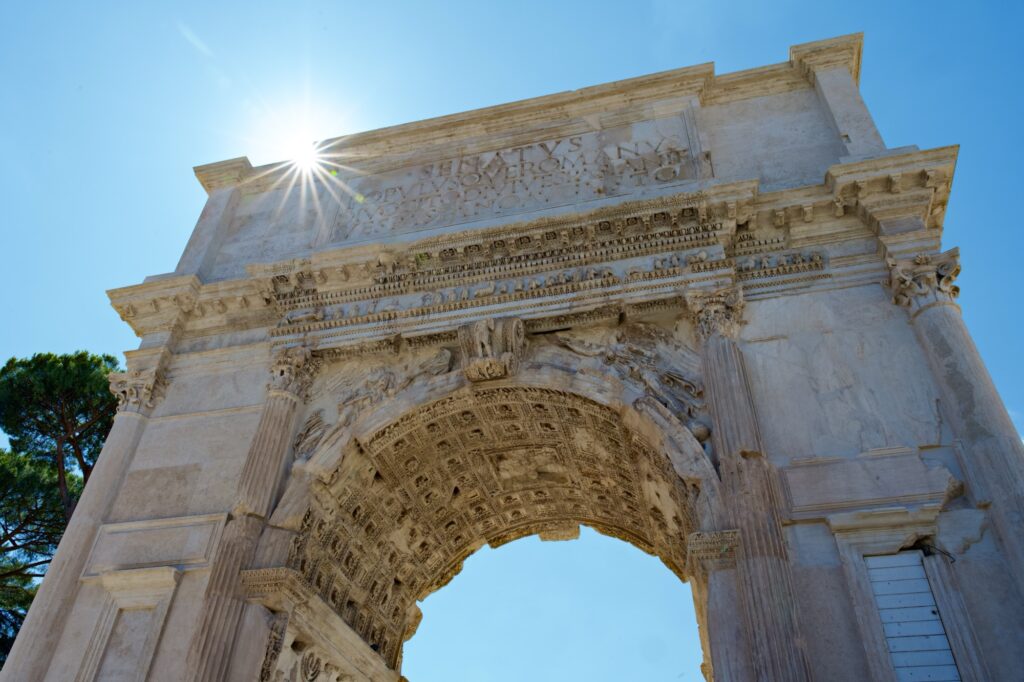
Our last stop in the Roman Forum was Titus Arch built to commemorate the triumph in the Jewish War of Jerusalem in AD 70. This was interesting to hear about from the Roman side, and I’ve studied the Jewish side of this revolt extensively while traveling in Israel. On the interior of the arch, you could see items that tied back to Jerusalem like a menorah. The arch was extensively restored in 1822.
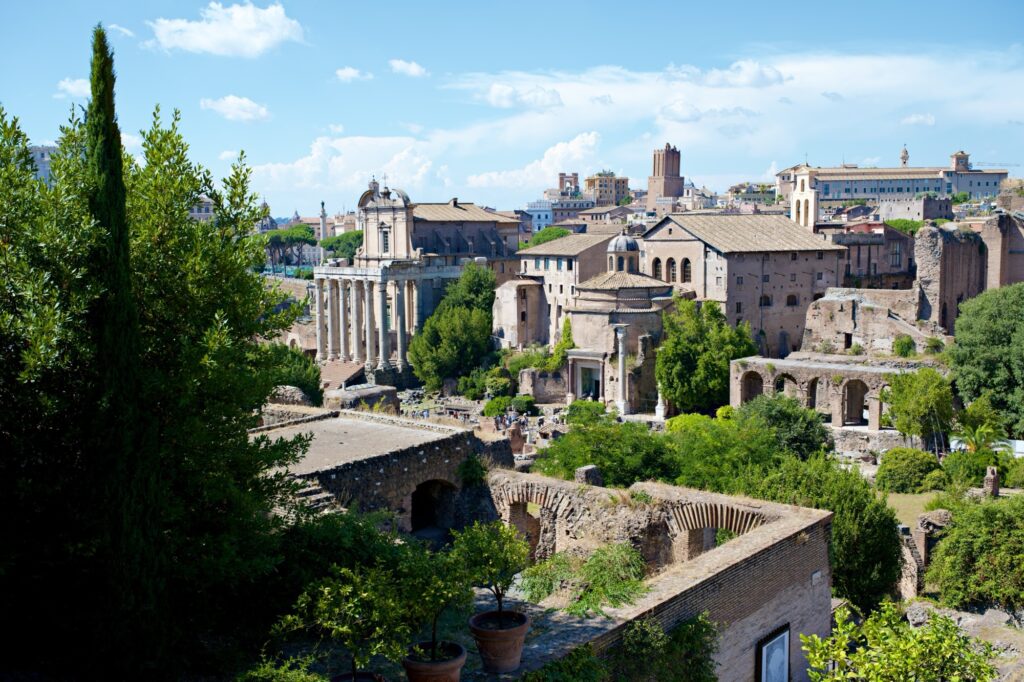
Next, Laura took us to the top of Palatine Hill (one of the 7 hills of Rome), for fantastic views of the Roman Forum and the Colosseum.
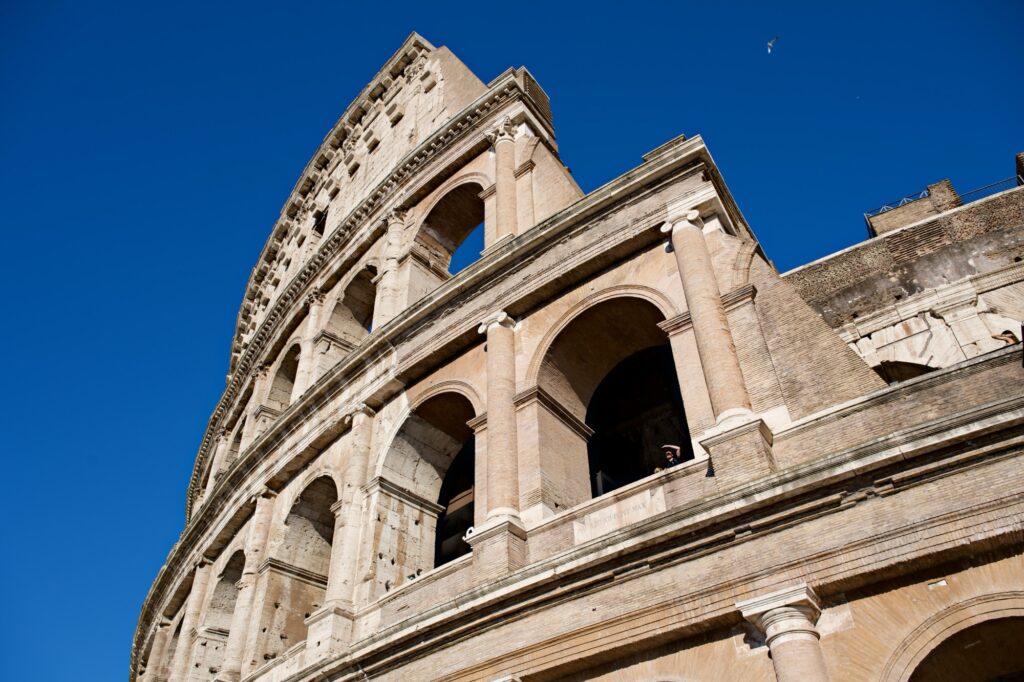
Finally, Laura began to take us to the Colosseum, which we learned was actually a nickname. The official name was the Flavian Amphitheater dedicated to the emperors of the Flavian dynasty. The nickname “Colosseum” came from the giant Colossus of Nero that was just outside this amphitheater.
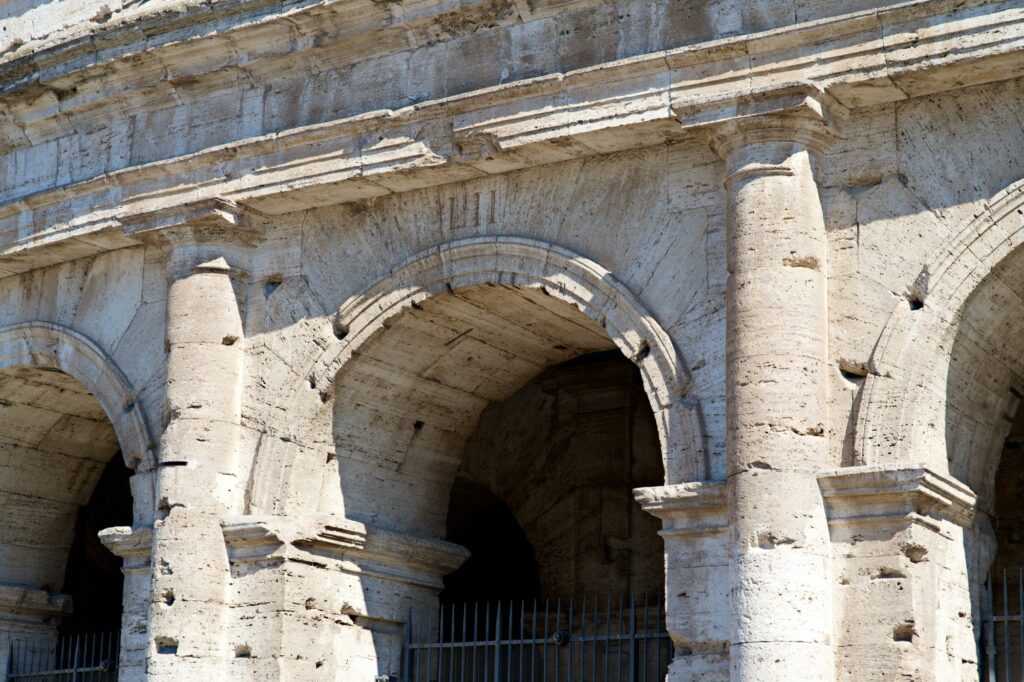
The Colosseum was built from 72 to 80 AD and was constructed from Roman travertine stone. The structure is 38 meters high and had 80 entrances marked by Roman numerals. Laura told us that 76 of these entrances were the for the public and 4 were for the Emperor and other dignitaries like the Vestal Virgins. The entrances (exits) were called vomitorium as they would expel the crowd at the completion of games. Because of the number of exits, the entire arena could empty in 15 minute even though there were between 50 and 60K spectators. 39 of the Roman numerals marking the exits are still visible today.
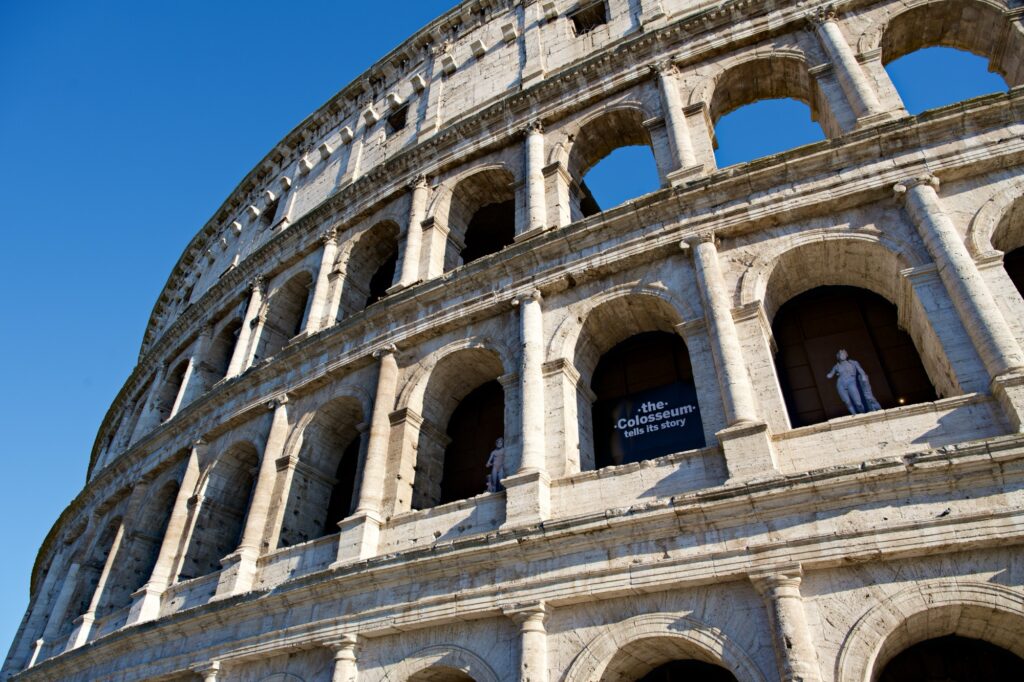
Each of these entrances had two sets of arches above them that contained 160 statues. The arena could be covered with a retractable awning (velarium) that was made up of 80 canvas segments and 240 poles.
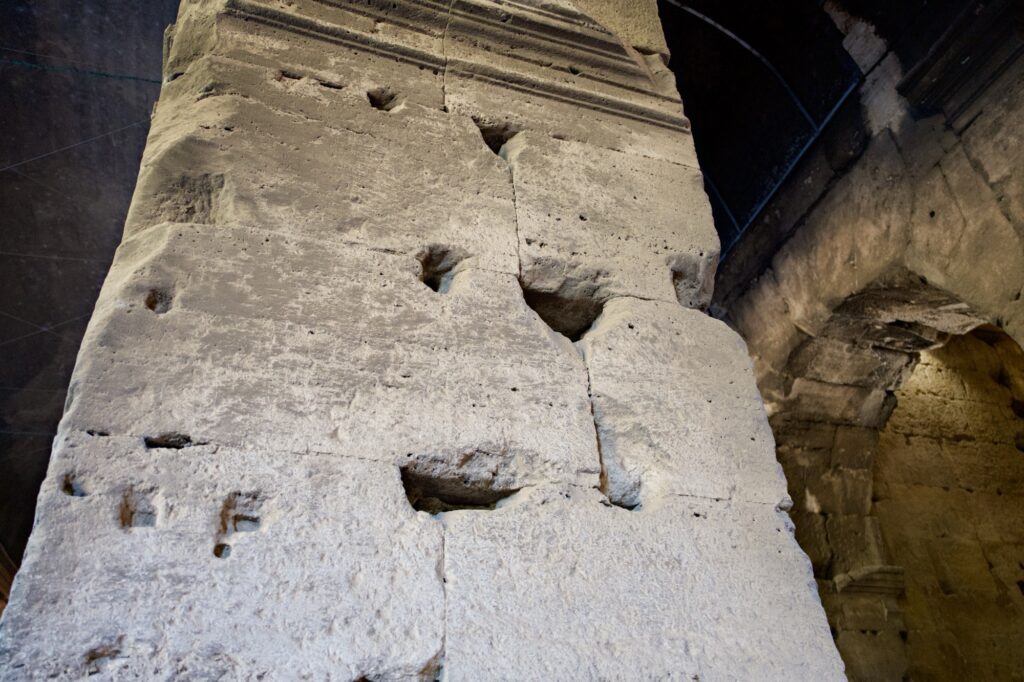
While much of the structure is made of Roman travertine, the large blocks were held together with metal clamps. Over the centuries, many of these metal clamps were taken by various Popes to be used in the construction of Basilicas throughout Rome. This left many holes in the travertine stone make it look like Swiss cheese.
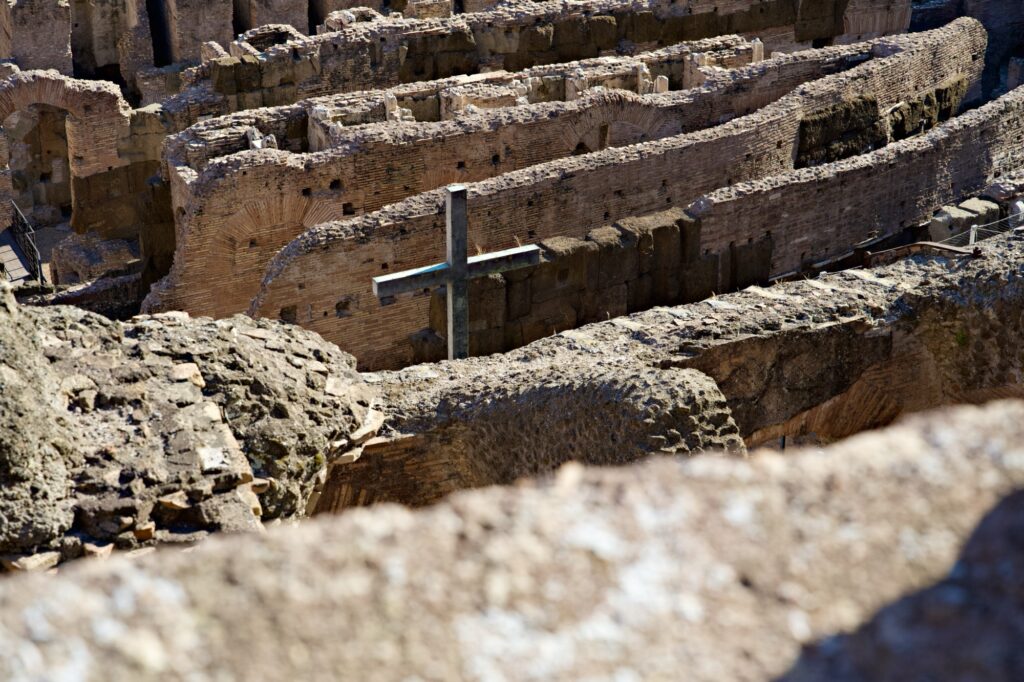
Pope Benedictus the XVI later consecrated the Colosseum as a Basilica dedicated to Christian martyrs to prevent further looting.
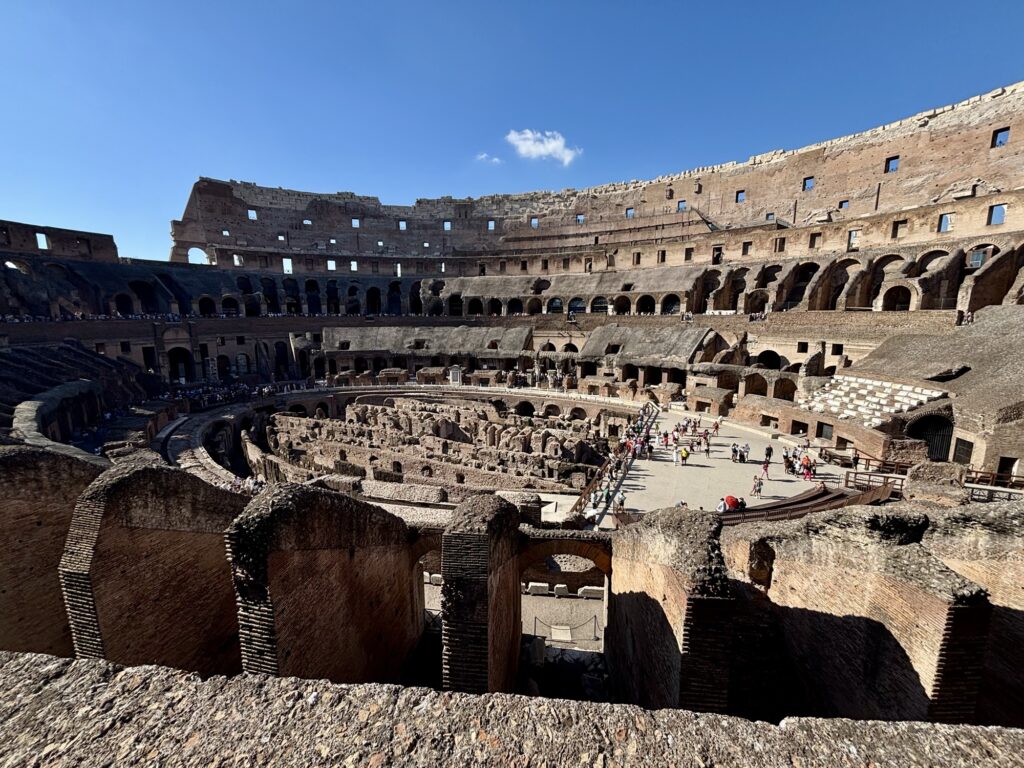
Upon completion of construction, the Flavian Amphitheater was opened with 100 days of games. The initial games included naval battles with a giant pool that was filled by an aqueduct in 7 hours. Six years after the opening of the Colosseum, the naval games were abandoned in order to build the underground tunnels for equipment, animals, and gladiators. This underground structure contained many elevators that operated with ropes, pulleys, and counterweights to be able to bring animals up to the arena floor.
Laura told us that a day of games at the Colosseum were divided in the three periods of the day. This included morning until lunchtime, lunchtime until dinner, and from dinner into the evening. The “games” included the fighting of exotic animals, events like a circus, and public executions that included crucifixions and beasts trained to attack men. Laura mentioned that kids were often brought to executions to deter future criminal activity.
Gladiator fights were always in the afternoon period. Gladiators trained and lived at school for gladiators near the Colosseum. Only the free men were paid to be Gladiators. If a slave could stay alive for three years, they would win their freedom. In Gladiator fights, the Emperor would determine if the loser would live or die (if they survived the actual fight). Unlike the depiction in movies, the Emperor would give a thumbs up for death (as depicting a sword being drawn from a scabbard) or would have the thumb tucked in to allow the loser to live (as depicting the sword remaining in the scabbard). Laura explained that sometimes these fights were choreographed like modern professional wrestling.
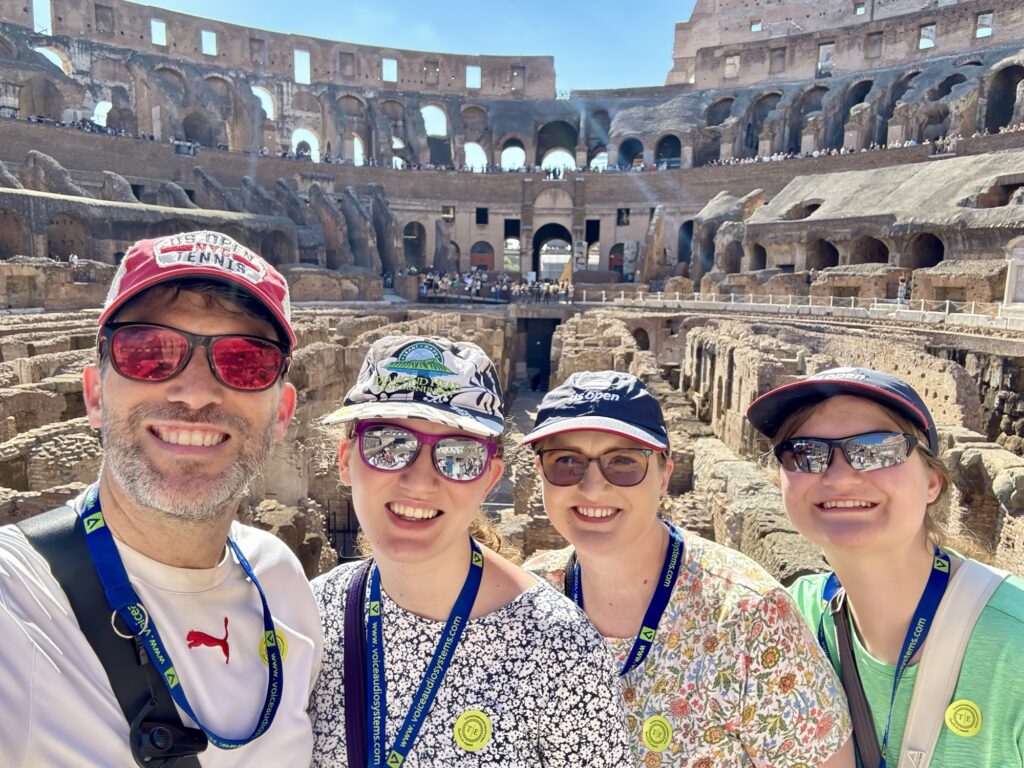
For our tour we walked around the ground level on the inside and then went onto the partially reconstructed arena floor (the original floor is completely gone). From here we clearly see the underground structures that were used for the games. We could also see the immense size of this structure. While on the floor, Laura pointed out a few of the original remaining marble seats.
Next we went to the second level and walked around the arena. This was where we said goodbye to Laura, but the four of us stayed for another hour or so walking around this level of the Colosseum. This is easily one of my favorite man-made structures I’ve ever visited. It was awesome!
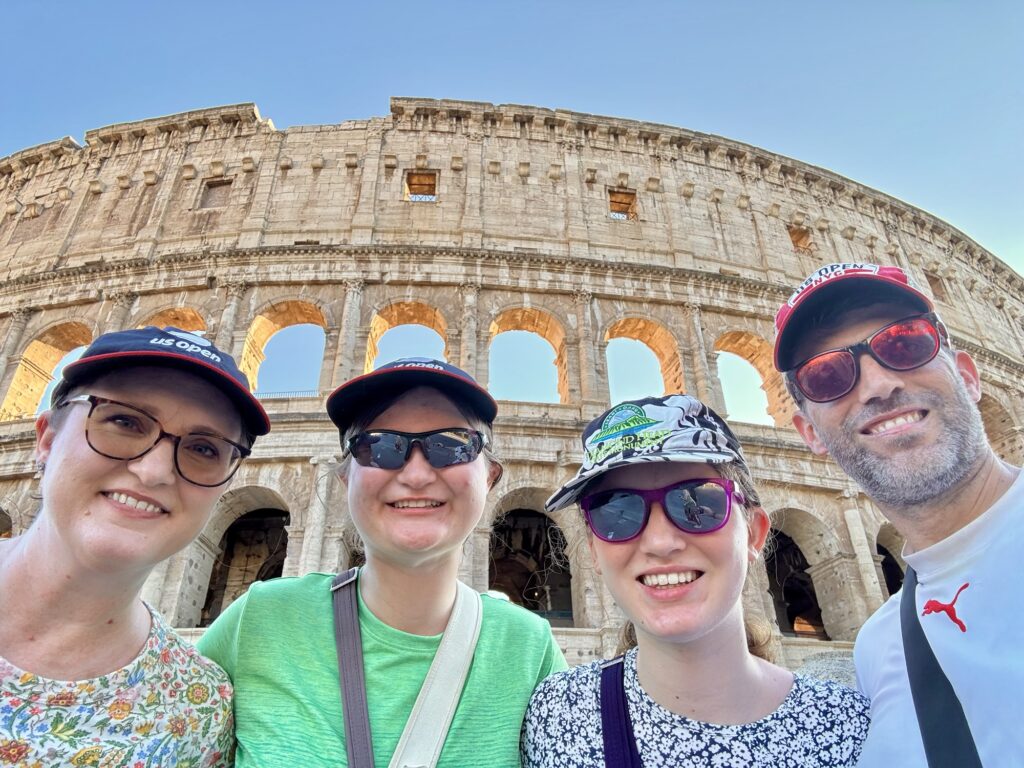
When we finally left the Colosseum, it was around 6:30 PM. Even though this was early for dinner in Italy, we began looking for a restaurant since we had only had gelato for lunch.
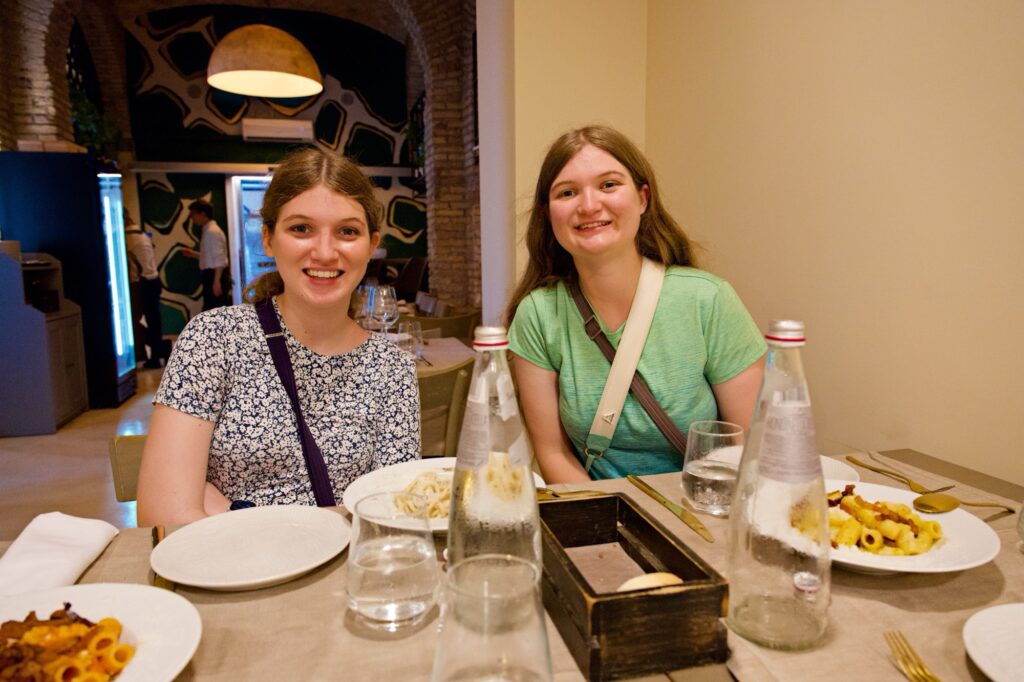
We ended up at Sampietrino L’osteria di San Giovanni near our hotel just after 7 PM. I knew this was an odd request in Italy, but I tried very hard to get our waiter to bring us four bottles of water since we were all pretty dehydrated. He didn’t really want to do this, but eventually brought us two bottles. After we quickly drank those, I again asked for four more from a different waiter. He seemed to agree to it, but then only brought us two. We finally got the original waiter to bring us two more for a total of six bottles. We’ve been talking ever since about how they probably got a good laugh about the crazy Americans and all their water.
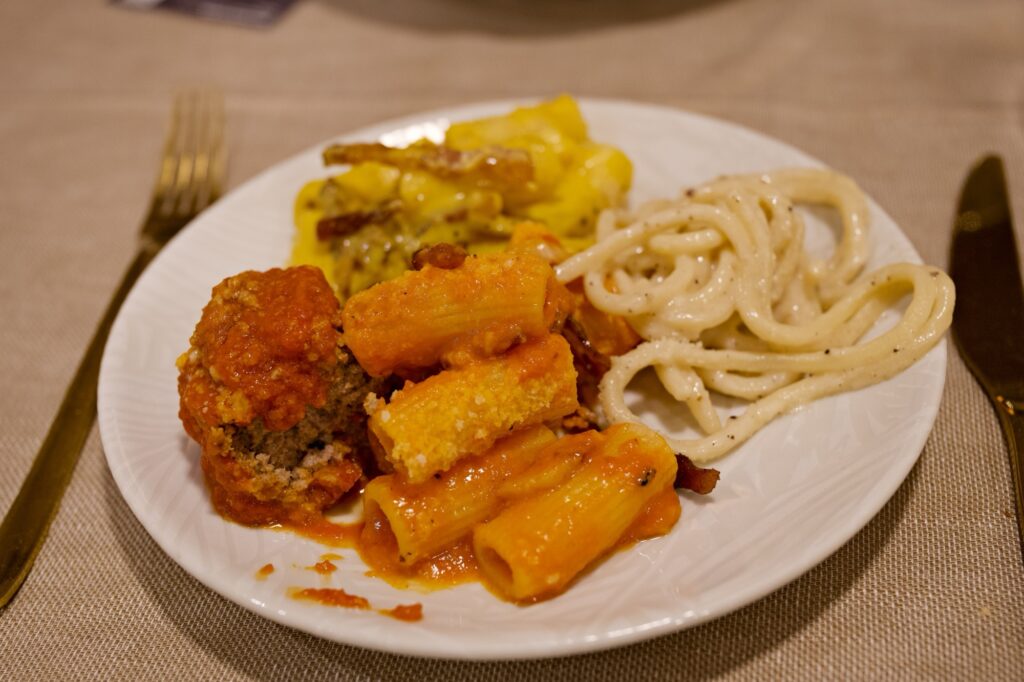
Anyway, we ordered Amatriciana, Carbonara, Super polpetta al sugo, and Tonnarelli cacio e pepe to split. It was all wonderful, and made for an enjoyable meal (especially with many laughs about the water).
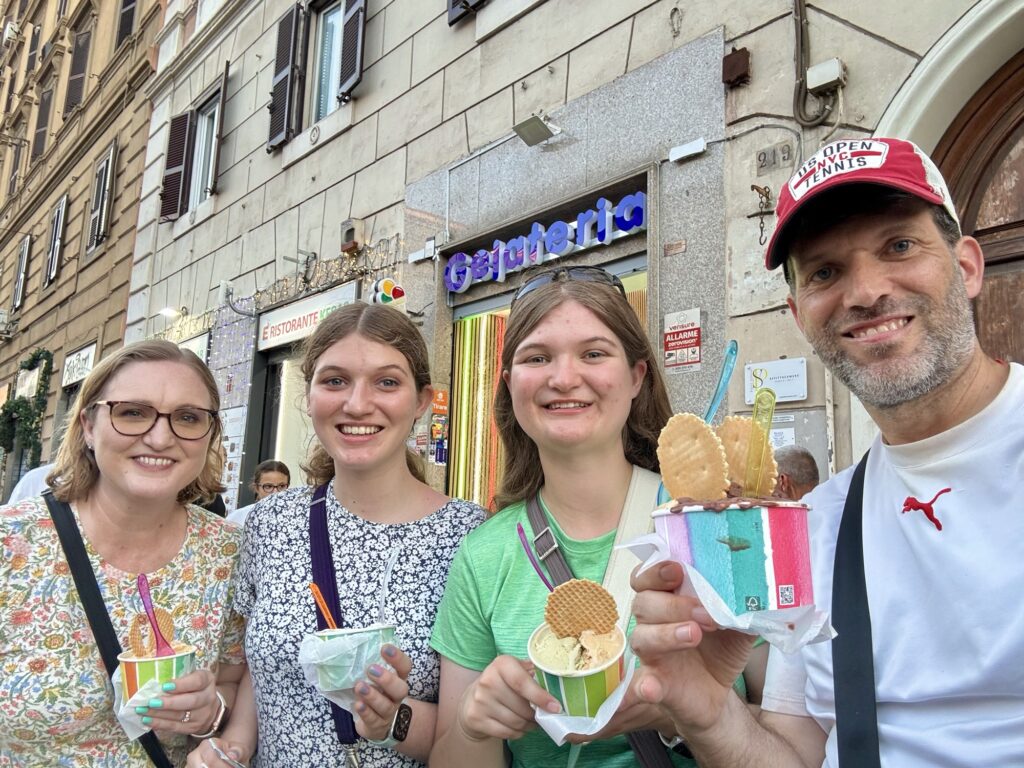
On our way back to the hotel, we again stopped for gelato at the same place we went on the first night in Rome. The owner remembered us and even took a picture of us for his Instagram. This time Olivia had dulce de leche, Kate had dulce de leche and pistachio, Sara had cherry, and I had chocolate and dulce de leche. It was amazing!
Back at the hotel, we cleaned up and then turned in for the night to rest up for another big day in Rome on Sunday!
